Reproducing Louis XV by Glen Beckford Frames
We at Glen Beckford Frames were asked by a very prestigious client of ours to reproduce a sample of a Louis XV frame for a painting by a prominent French artist. Louis XV frames are exquisitely carved and gilded picture frames from the period 1723-1774. They have highly decorated and strong corners with empty plain spaces of moulding to give balance to the frame. The panels are sanded and the gesso recut to give even more detail. The top rails are swept and consist of many S and C scrolls along with loops in the corners.
Figure 1: Sample of Louis XV Frame
Here in Figure 1 we can see the sample of the frame that was requested for us to reproduce. The sample is in reasonable condition and was previously oil gilded, however, we were asked to water gild the reproduction.
The first stage is to have the frame put together in the wood in order for it to be carved (Figure 2). At this stage the mouldings are made in lengths of wood, cut and mitred to the correct size, keyed and glued together. Additional wood is added to the centres and corners of the frame to replicate what the finished frame will look like after it has been carved.
Figure 2: Frame in Wood to be Carved
Next the frame is hand-carved by specialist carvers in true Louis XV style to replicate the sample frame (Figure 3). Frames can also be machine carved, however, in all our 40 years of business we have always hand-carved our frames as this gives the frame a better quality and its unique individual identity.
Figure 3: Frame being Carved by Specialist Carver
Once the frame has been delicately carved it is sanded with different grades of sand paper until it is smooth. It is after this that we apply boiling hot size which is then left to dry. The purpose of the boiling hot size is to seep into the wood and seal the frame. After the frame is dry which can take up to 24 hours, the frame is now ready to be gessoed. Anywhere between five to fifteen coats of gesso will then be applied depending on the type of frame. After the frame has been gessoed it is left bright white in appearance (Figure 4). At this stage the frame is again left to dry between each application of gesso. When dry the frame is again sanded with different grades of sand paper to give a smooth finish. However, even after this the frame has to go through a process called ‘wet and dry’ whereby the gessoed frame is wet with water and sand papered to give an even smoother finish. Once dry the frame is again sand papered with very fine grade sand paper to give an extra smooth finish.
Figure 4: Frame in Gesso
Now that the frame has been gessoed and is also very smooth in appearance and touch the flat panels are sanded in true Louis XV style. Sanding the panels is done by applying a mixture of gesso, white glue and water to the panels and sprinkling sand onto the section while the mixture is still wet. This is then left to dry and the loose sand removed. Next is the process
which is very critical in bringing character and intricacy to the frame. This process is where special re-cutting chisels are used to add extra detail and decoration to the frame. The gesso is re-cut mainly along the carvings and also on the front edge of the frame (Figure 5).
The difference in detail between Figure 4 and Figure 5 is very noticeable as the scrolls, flowers, leaves and shields are brought to life by the added detail.
Figure 5: Sanded panels & Re-cutting of gesso
Now that the frame has been re-cut, gesso is then put onto the sanded panel and left to dry for the next stage which is applying a mixture of size and yellow ochre clay. After that has been done a mixture of red clay and size is then added on top of the yellow ochre. The red clay is coloured to a specific shade of red to complement the painting. This is important when it comes to toning the frame to ensure that the colours resonating through the gold supplement the painting within the frame.
Figure 6: Red Clay on top of Yellow Ochre
At Glen Beckford Frames we believe that a frame should be able to be hung on the wall before it has been gilded and still look great. As Figure 6 shows, this frame would look great hung on the wall with the painting within.
It is at this stage that the frame is ready to be gilded. The frame is water gilded using 23.75ct loose gold leaf as can be seen in Figure 7.
Figure 7: Gilding Cushion with Gold Leaf
Once the frame is completely gilded it is then burnished with a burnishing stone and toned. In Figure 8 we can see the frame after it has been gilded, burnished and slightly toned.
Figure 8: Frame Fully Gilded and Slightly Toned
The frame is then toned to complement the painting or sometimes to match a sample. In Figure 9 we can see Glen Beckford in the process of toning the frame to match the sample.
Figure 9: Glen Beckford Toning the Frame
Figure 10 shows the completed frame. The colours of the clay can be seen coming through the gold with the toning making the frame look antiqued and toned.
Figure 10: Completed Frame
So here we have the completed frame alongside the sample provided. In this case the client asked for the reproduction to have more weight than the sample, hence why it looks slightly bolder than the sample
Figure 11: Completed Frame Alongside Sample



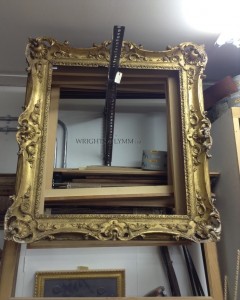
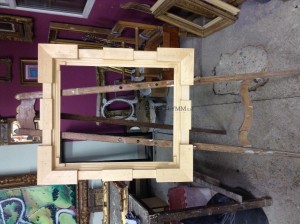
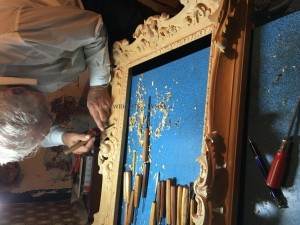
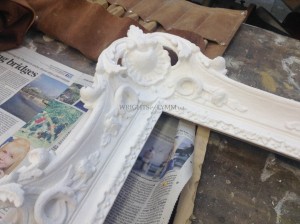
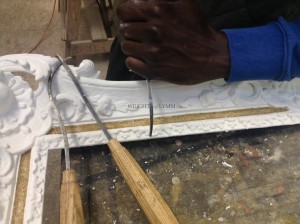
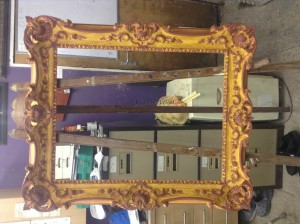
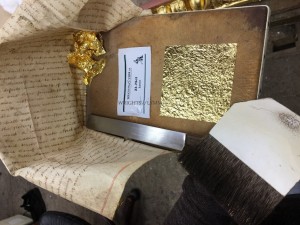
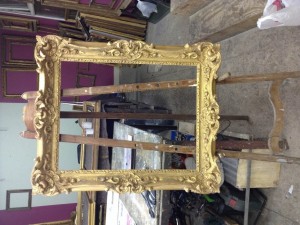
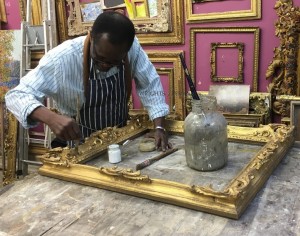
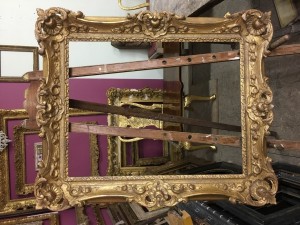
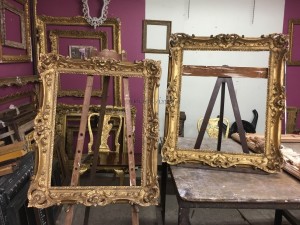
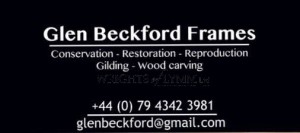
My Account
Create New Account